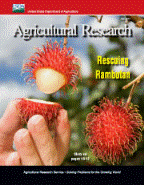United States Department of Agriculture: Agricultural Research Service, Lincoln, Nebraska

Agricultural Research Magazine
Date of this Version
1-2013
Document Type
Article
Citation
Agricultural Research January 2013.
Abstract
There is no typical drainage ditch,” says Agricultural Research Service ecologist Matt Moore. “And until recently, farmers just thought of them as something they need to drain water off their fields. But we can use these ditches to minimize pesticide and nutrient losses in runoff—and it can be done without taking any cropland out of production.”
Moore, who works at the ARS National Sedimentation Laboratory in Oxford, Mississippi, has been wading through edge of- field drainage ditches since he was a boy planting rice on his family’s farm in Arkansas. The ditches—as common in agricultural landscapes as the fields they drain—range from shallow gullies that sometimes run dry to much larger channels that hold either standing or flowing water throughout the year.
Many farmers control ditch vegetation with trimming or dredging to eliminate barriers that could impede the flow of runoff. But Moore has conducted a number of studies over the past 10 years showing that drainage ditches where plants are allowed to flourish are strikingly effective at keeping agricultural pollutants in field runoff from reaching surrounding surface waters.
Blocking a Path for Pesticides
In one of Moore’s first studies, he spent 28 days evaluating the transport and capture of atrazine and lambdacyhalothrin in a 160-foot section of a vegetated agricultural drainage ditch in Mississippi. One hour after he started a simulated runoff event, 61 percent of the atrazine and 87 percent of the lambda-cyhalothrin had transferred from the water to the ditch vegetation, and at the end of the ditch, runoff pesticide concentrations had decreased to levels that were generally nontoxic to downstream aquatic fauna.
“I was surprised by the short distance the runoff needed to travel in the drainage ditch to lose its pesticide load,” says Arkansas State University researcher Jerry Farris, who was one of the coauthors on the study. “This suggested that we could use these ditches as one tool in managing agriculture from an ecological perspective.”
Included in
Agriculture Commons, Animal Sciences Commons, Food Science Commons, Plant Sciences Commons

